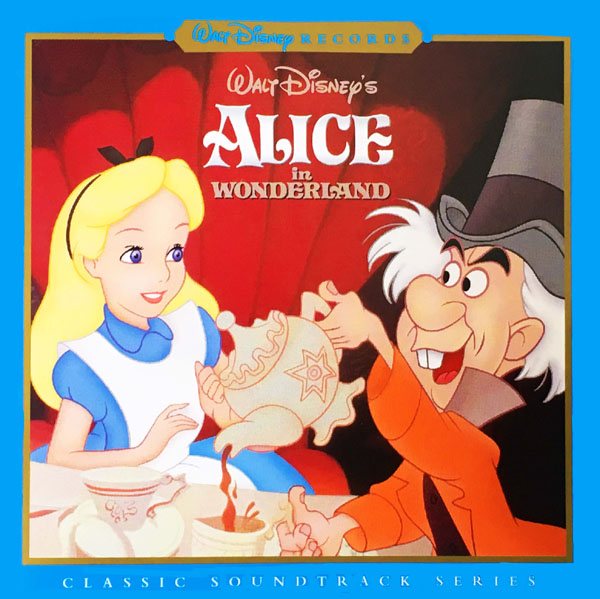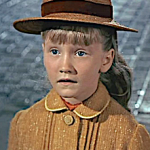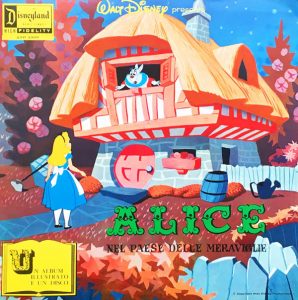A 70th birthday salute to Walt Disney’s Alice in Wonderland and the soundtrack album released almost 50 years after it premiered.

Walt Disney’s
ALICE IN WONDERLAND
Classic Soundtrack Series
Walt Disney Records 60960-7 (Compact Disc / Mono)
CD Reissue: “Disney Original Soundtrack,” same date & number, slight changes to tray card and booklet.
Currently available on various streaming and download services.
Released in December 1997. Digital Restoration Producer/Editor: Randy Thornton. Digital Restoration Executive Producer: Ted Kryczko. Composer/Musical Director: Oliver Wallace. Orchestrations: Joseph S. Dubin. Vocal Arrangements: Jud Conlon. Art Direction: Luis M. Fernandez. Design: Susan Andrade. Audio Researcher; Glenn Ragland. Restoration/Mastering: John Polito. Special Thanks: Les Perkins, Scott MacQueen, Harry Arends, Jonathan Heely, Matt Crandall, Buena Vista Sound Transfer. Running Time: 56 minutes.
Voices: Kathryn Beaumont (Alice); Ed Wynn (Mad Hatter); Jerry Colonna (March Hare); Richard Haydn (Caterpillar); Bill Thompson (White Rabbit, Dodo); Verna Felton (Queen of Hearts); Sterling Holloway (Cheshire Cat); Norma Zimmer (White Rose); J. Pat O’Malley (Tweedle Dee, Tweedle Dum, Walrus, Carpenter); The Mellomen (Cards).
Songs: “Alice in Wonderland,” “In a World of My Own,” “I’m Late,” “The Caucus Race,” “The Walrus and the Carpenter,” “All in the Golden Afternoon,” “Very Good Advice,” “Painting the Roses Red,” “Who’s Been Painting My Roses Red?” by Bob Hilliard, Sammy Fain. “How D’ye Do and Shake Hands” by Cy Cohen, Oliver Wallace. “We’ll Smoke the Blighter Out” by Winston Hibler, Ted Sears, Oliver Wallace. “Old Father William,” “A-E-I-O-U (The Caterpillar Song)” by Oliver Wallace, “’Twas Brillig” by Don Raye, Gene DePaul; “The Unbirthday Song,” by Al Hoffman, Mack David, Jerry Livingston; “Sailor’s Hornpipe” (Traditional).
Instrumentals: “March of the Cards” by Sammy Fain; “Pay Attention,” “Curiosity Leads to Trouble,” “Simply Impassible,” “We’re Not Waxworks,” “Mary Ann!” “A Lizard with a Ladder,” “The Garden,” “What Genus Are You?” “Who R U?” “Keep Your Temper,” “A Serpent!” “Alone Again.” “Lose Something,” “The Mad Tea Party,” “Clean Cup Move Down,” “The Tulgey Wood,” “Whom Did You Expect,” “The Queen of Hearts,” “A Little Girl,” “Let the Game Begin,” “I Warn You Child,” “The Trial,” “Rule 42,” “Off With Her Head,” “Please Wake Up Alice,” “Time for Tea” by Oliver Wallace.
“When word came down that I was going to be able to restore the soundtrack to Alice in Wonderland, I nearly jumped out of my seat,” said Walt Disney Records Producer and Historian Randy Thornton.Verse: “How Doth the Little Crocodile?” “Twinkle, Twinkle” and other song lyrics adapted from Alice’s Adventures in Wonderland and Through the Looking Glass by Lewis Carroll.
Alice had long been a “Holy Grail” among Disney soundtracks, as it had never been released as a soundtrack album before in the U.S. There were only a few exceptions abroad.
In the seventies, Pickwick International issued “Alice in Wonderland,” “How D’ye Do and Shake Hands,” “I’m Late” and “The Unbirthday Song” on some compilations, including Walt Disney’s Original Soundtrack Parade, Volume 2. Also, Disneyland Records Italy released an edited version of the entire film soundtrack (dialogue, music and sound effects) in Italian package as a single album or with a storybook.
The single most distributed version for five decades was Tutti Camarata’s superb interpretation of the score with Darlene Gillespie (and is still the longest-available recorded version). To find out why the soundtrack was not released for so many years, and the history the Camarata version, it is all explained in detail here.
 “Unlike the other classic films in which the songs were specifically written to move the story along, Alice’s songs were puzzlements—the music was set, in many cases, to the classic verse of Lewis Carroll,” Randy states in the liner notes. “And as Mr. Carroll would have appreciated, most of the songs seem to appear out of nowhere and disappear without notice. A score cue may melodically go on for a minute or two and then transition into a song. This meant that a song was part of the score and not indexed for the listener’s easy access… songs intertwine; the Dodo sails in and out; and the Cheshire Cat taunts you as he did Alice. Some songs are more like poems with music, such as ‘Twinkle Twinkle’ as told by the Dormouse and ‘How Doth the Little Crocodile’ recited by the Caterpillar. All this makes for a rather unconventional listening experience, but no more unconventional than Wonderland itself.”
“Unlike the other classic films in which the songs were specifically written to move the story along, Alice’s songs were puzzlements—the music was set, in many cases, to the classic verse of Lewis Carroll,” Randy states in the liner notes. “And as Mr. Carroll would have appreciated, most of the songs seem to appear out of nowhere and disappear without notice. A score cue may melodically go on for a minute or two and then transition into a song. This meant that a song was part of the score and not indexed for the listener’s easy access… songs intertwine; the Dodo sails in and out; and the Cheshire Cat taunts you as he did Alice. Some songs are more like poems with music, such as ‘Twinkle Twinkle’ as told by the Dormouse and ‘How Doth the Little Crocodile’ recited by the Caterpillar. All this makes for a rather unconventional listening experience, but no more unconventional than Wonderland itself.”
Therefore this soundtrack takes listeners on the same musical journey as Alice, only we are hearing virtually all of the musical material free of dialogue and sound effects. Oliver Wallace’s Academy Award-nominated underscore is a joy to behold, along with Joseph S. Dubin’s orchestrations, Jud Conlon’s choral work and the delightful character vocals by Verna Felton Richard Haydn, Jerry Colonna, Bill Thompson and Disney Legends Kathryn Beaumont as Alice and Ed Wynn as the Mad Hatter.
The visuals of Walt Disney’s Alice can be so overpowering, it’s easy to miss a lot on the music track when captivated by the screen images. The effect of hearing the album can be somewhat of a revelation.
This compact disc has been reissued several times here and in Europe and is currently streaming on several services. To date, this version of the soundtrack has still never been released on vinyl (Walt Disney Records’ recent picture disc is the Camarata version).
The Trial / The Unbirthday Song / Rule 42 / Off With Her Head / The Race
On a traditional Disneyland vinyl soundtrack album (had there been one), this entire track might have simply been called “Finale.” It’s a great example of the dynamism of Oliver Wallace’s highly effective score, a blend of the surreal with the frantic (that spinning cloud chase cue is a wonder in itself) and the breakneck change of gears scoring so much action into just a few minutes. Also, listen for the extra rendition of the title song after the big finish, it was the one and only time in a Walt Disney animated feature that there was a cast list at the end of the film.
When Disneyland Park’s Fantasyland was revamped in 1983, the Alice in Wonderland attraction (a ride-through experience that exists nowhere else on earth) was given one of the most extensive renovations, including a spectacular reworking of the musical score that involved expert consultants like music historian Stacia Martin and writer/producer Les Perkins. John Debney, not only one of Hollywood’s top film and TV composers but also a child of Disney (who as the son of production manager Lou Debney “grew up at the studio”) lovingly recreated the Alice music in full stereo.

“As she had for the 1958 attraction, Kathryn Beaumont returned to narrate the show as Alice,” wrote Stacia in her comprehensive companion book from the CD box set, A Musical History of Disneyland, “Thurl Ravenscroft also revisited his original movie roles as both a bass dandelion and a hapless card gardener, frantically trying to paint white roses red.
“Over two days in September 1983, Debney conducted whistling paying cards, tenor daffodils, and a full orchestra of 49 musicians. One memorable session featured Debney’s whimsical arrangement of “The Unbirthday Song,’ orchestrated by Ira Hearshen for an eleven-piece band of ocarina, flutes, piccolos, violins, tin whistles and chromatic bottles and jugs! To prepare for the afternoon session, the vessel instrumentalists spent the lunch break in a corridor with a pitch-pipe and a drinking fountain, adding and subtracting drops of water until the bottle next could be blown upon in tune.”
“Alice in Wonderland” with Karen Dotrice
 To give this celebration of Alice in Wonderland another Disney-related touch, here is a lavish 1965 two-disc musical adaptation produced just for records starring “Jane Banks,” Karen Dotrice, produced around the same time as Mary Poppins was filmed. With music by Philip Green and lyrics by Norman Newell (and Lewis Carroll), it is packed with British legends of comedy and drama.
To give this celebration of Alice in Wonderland another Disney-related touch, here is a lavish 1965 two-disc musical adaptation produced just for records starring “Jane Banks,” Karen Dotrice, produced around the same time as Mary Poppins was filmed. With music by Philip Green and lyrics by Norman Newell (and Lewis Carroll), it is packed with British legends of comedy and drama.
The musical director/orchestrator is Brian Fahey, who worked with Tutti Camarata on almost every one of Disney’s UK-based recordings in the late sixties. Film star Dirk Bogarde (A Bridge Too Far, the Doctor in the House movies) narrates. Other actors who might be familiar to U.S. audiences are Peggy Mount (Queen of Hearts), who played Widow Corney in 1968’s Oliver! (singing the title song with Harry Secombe); Bruce Forsyth (March Hare), who played sinister Swinburne in Bedknobs and Broomsticks and guested on The Muppet Show; Kenneth Connor (White Rabbit), who appears in the Carry On films frequently aired on TCM; and Harry H. Corbett (Gryphon), the “son” of Steptoe and Son (the original British version of Sanford and Son, easily accessed on YouTube).



 GREG EHRBAR is a freelance writer/producer for television, advertising, books, theme parks and stage. Greg has worked on content for such studios as Disney, Warner and Universal, with some of Hollywood’s biggest stars. His numerous books include Mouse Tracks: The Story of Walt Disney Records (with Tim Hollis). Visit
GREG EHRBAR is a freelance writer/producer for television, advertising, books, theme parks and stage. Greg has worked on content for such studios as Disney, Warner and Universal, with some of Hollywood’s biggest stars. His numerous books include Mouse Tracks: The Story of Walt Disney Records (with Tim Hollis). Visit 






















































I must say, nearly every time you revisit the matter of ALICE IN WONDERLAND on records I find myself elated. I am certainly a considerable fan of the music of Disney films, but I am especially fond of the score and songs for ALICE; I believe that the work of the various composers and songwriters playfully and aptly bring a lot of Lewis Carroll to life. I’m always glad when you feature the film in your columns. Thanks.
The English “Alice in Wonderland” record suffers in comparison to the Disney product. The music is lovely and well orchestrated, but the lyrics are embarrassingly bad. As for Karen Dotrice, she’s a sweet girl, but it’s no wonder she never went on to a singing career.
I wonder if you’re familiar with the music of David Del Tredici, who won the Pulitzer Prize for composition in 1980. Much of what he’s written was inspired by Lewis Carroll, especially Alice. It’s not kid’s stuff by any means!
No, I am not, but I found a collection of his Alice music on YouTube. The paths to and through Wonderland are so varied, I guess that is what makes a classic. To me, it’s like a documentary as we navigate through life, trying to make sense of nonsense, where there’s cranky for every cute and you’ve learned something yet you haven’t. The Disney movie ends with Alice going to have tea and we don’t know really if the whole experience made any difference, and yet for 70 years now, of course it has, and in the book’s case, it’s over 150 years. “A little nonsense now and then is relished by the wisest men.”
Man, I could kick myself! (Nobody volunteer to do it for me!) My dad had a Japanese – I believe – version of ALICE IN WONDERLAND – a song and some music form a vintage 45 rpm record that he got not long after when he was sent to South Korea in 1953 – even though the supposed to be officially “over.” It wasn’t! Anyway, he brought back a couple of old “45”‘s and one of them had music form ALICE IN WONDERLAND on it. I don’t remember if one of us kids broke it, or it got played too much – but I think after awhile Mom tossed it out! I wish now, I still had it!